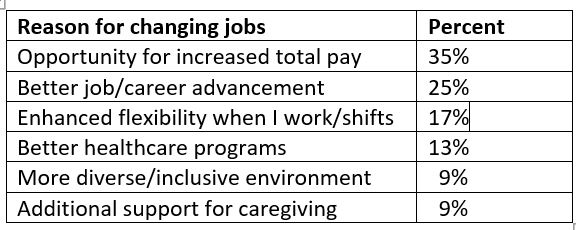When Enterprise Connect finally went back to being fully in-person last March, the big story at the show was getting the human touch back and connecting face-to-face with colleagues once again. This was a good sign that people are ready to get back to live events, but what Enterprise Connect attendees really wanted to know was how things were going with this new thing called “hybrid work.”
The term has quickly become part of the vernacular for 2022. We’ve been talking about it virtually for a while, but this was the first time since then that people in our space could learn en masse how hybrid work was going, not just from enterprises but the vendors as well.
There was plenty to talk about, and the consensus was that there was no consensus on hybrid work. We’re all figuring it out as we go, and there’s no success formula that we can follow step-by-step. Turn to your left, and there’s a hybrid work success story; then turn to your right, and you’ll hear about a plan going from bad to worse.
As much as hybrid work seems to be the model going forward, the picture doesn’t seem any clearer today. To illustrate, I’m going to share some highlights from a recent global study conducted by Ernst & Young (EY),
2022 Work Reimagined. The study was produced by their People Advisory Services practice, and one of their Managing Directors, Barbara Steel, gave a top-line presentation about it at my
Future of Work Expo event in June.
What Employees and Employers Can Agree On
For hybrid work to really work, there has to be some common ground. Ideally, it should be about things that are going right, but failing that, if it’s about things that are problematic, there’s an opportunity to build consensus and find a way forward. The latter is what stands out for this study, where both parties are largely on the same page in this regard:
Given the impact of the pandemic, changes should be made to total rewards
Agreement with this position was high across the board, with 79% of employees and 83% of employers feeling that changes are needed. That sounds like a good starting point, but it’s also fair to say that the “impact” of the pandemic can be highly subjective, as well as what constitutes “total rewards.” It’s not a big leap to say that this “changes should be made” sentiment aligns with the Great Resignation trend, and the broad malaise around how people are prioritizing work as we come out of the pandemic.
The research certainly bears this out, as employees are more willing to leave their jobs or want higher pay in order to stay put. Whereas the 2021 edition of this study found that only 7% were likely to leave their employer in the next 12 months, that number jumped to 43% in 2022.
In absolute terms, that level should be concerning, and a deeper look at demographics shows that it’s even more acute among younger workers. Almost half of Gen Z and Millennial workers feel this way – 48% of each group - compared to only 28% among Baby Boomers. This is just one of many examples of how the Great Resignation must be viewed with nuance and not generalized across the board.
Where Employee and Employer Views Diverge
Now let’s bring “total rewards” back into the picture. When asked whether pay increases or reviews are needed to mitigate staff turnover, the views between employees and employers start to sharply diverge. They may all view the Great Resignation as being problematic, but money seems to be more of a concern for employees, where 42% felt this way, compared to only 18% among employers.
If there was any doubt about the primacy of pay for employees, consider how employees responded to the following question:
If you would consider another offer, what are the primary reasons you would change jobs?
These are selective responses from a longer list, but total pay is clearly the strongest driver. U.S. Labor statistics suggest the economy is near full employment, and to whatever extent you believe that, we seem to be in a seller’s market. As long as the job market remains strong, workers will feel empowered to look elsewhere, especially for higher pay. That said, for all the talk about leaving due to issues like a toxic workplace culture or inflexible workstyles, those concerns seem pretty secondary to money.
In defense of employers, they should not be faulted for being sensitive to how disruptive the pandemic has been for all of us. There doesn’t seem to be much going back to pre-pandemic times, and employees and employers are trying to navigate the hybrid work landscape. No employer is going to suddenly abandon DEI programs or scale back healthcare benefits, even if they only have a minor impact on employee retention. On the other hand, the above data does suggest that a higher pay scale will go a long way to reducing staff turnover.
What About Workplace Culture?
Money may be the most tangible factor driving retention and job performance, and culture is probably the least tangible. Intuitively, we all know how important culture is, but we also know how challenging culture can be to maintain with the shift to work-from-home. Interestingly, the data shows a different impact of the pandemic on culture and is another example of how employees and employers aren’t really on the same page.
The study doesn’t specify what “culture” means, so we can only read so much into the data. However, just by looking at the results above, employees and employers are seeing things quite differently from this time last year. Clearly, employees think
company culture has improved, while employers think the opposite. This doesn’t necessarily mean that culture has gotten
worse, but consensus is definitely lacking.
Participants weren’t probed to learn in what ways culture has changed, so we can’t tell if they’re coming from a good or a bad place. For employees, my inference is that culture has “gotten better” because hybrid work allows them to balance time spent in the office and at home. Perhaps workplace culture is a mixed bag, and two or three days in the office is enough, but four or five days is detrimental.
Conversely, it’s worth noting that
divorce and separation rates have climbed during the pandemic, so while that time away from the office might be good for workplace culture, it may – sadly – have the opposite effect on home life. I’m sure there are other ways to read this data, but my take is hybrid work might help sustain or even enrich company culture as flexible work becomes the norm.
Employers, however, see things differently, and as the preference for home-based work grows, many will predictably lament the loss of control and having workers onsite full-time. While that shift is a defining trend for hybrid work, it’s an open question as to how that truly impacts culture. EY’s research doesn’t explore that, so one can only extrapolate so much from this particular data set. That said, there must be good reason why employees think culture is better now, and to mitigate against the Great Resignation, it would behoove employers to better understand this and build on that positive sentiment.
Collaboration Solutions Do Have a Role to Play
Given that the EY study was about rethinking the workplace, the research was mainly built around employee-employer dynamics. While this aligns well with my future of work focus, the role of technology cannot be overlooked. As much as the No Jitter audience is tech-centric, studies like EY’s seem to show that success with hybrid work is mostly about getting alignment between what employees and employers want. Not surprisingly, HR is very much in the middle of all this, where issues such as pay, career development, and workplace policies seem to carry most of the weight.
This particular study made no reference to IT issues or the role that technology vendors can play in making hybrid work successful. However, the report concludes with five recommendations, including one that tech vendors will be happy to see: “Create the work-technology experience – provide tools for collaboration, productivity, and learning to match the person with the work-tech experience.”
Considering that UCaaS vendors continue to post healthy growth metrics, it would seem they are well-positioned to address that need. However, IT leaders should be mindful of how far UCaaS can take them for the bigger challenge of making hybrid work, work. My broader thesis here is that until employees and employers get on the same page – especially for keeping the Great Resignation in check – no amount of technology innovation is going to save the day.
This post is written on behalf of BCStrategies, an industry resource for enterprises, vendors, system integrators, and anyone interested in the growing business communications arena. A supplier of objective information on business communications, BCStrategies is supported by an alliance of leading communication industry advisors, analysts, and consultants who have worked in the various segments of the dynamic business communications market.













